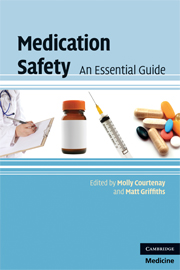Book contents
- Frontmatter
- Contents
- List of contributors
- Preface
- 1 Introduction to medication errors and medication safety
- 2 Safety in prescribing
- 3 Safety in dispensing
- 4 Safety in administering
- 5 Adverse drug reactions and drug interactions
- 6 Interface of care and communication
- 7 Parenteral drug administration
- 8 Calculations
- 9 Controlled drugs and patient safety
- 10 Reporting medication errors and near misses
- 11 Ensuring safety through evidence-based medicine
- Index
- References
3 - Safety in dispensing
Published online by Cambridge University Press: 22 January 2010
- Frontmatter
- Contents
- List of contributors
- Preface
- 1 Introduction to medication errors and medication safety
- 2 Safety in prescribing
- 3 Safety in dispensing
- 4 Safety in administering
- 5 Adverse drug reactions and drug interactions
- 6 Interface of care and communication
- 7 Parenteral drug administration
- 8 Calculations
- 9 Controlled drugs and patient safety
- 10 Reporting medication errors and near misses
- 11 Ensuring safety through evidence-based medicine
- Index
- References
Summary
When someone is prescribed a medicine, he or she expects the doctor to have made the right choice, and to receive what the doctor has ordered. Ensuring that these expectations are fulfilled is a fundamental part of the pharmacist's job, but most people waiting for prescriptions are probably unaware of the routines that are designed to keep them safe. Instead, they may watch staff at work and wonder why dispensing a few tablets can take so long. As for prescribing (Nemeth & Cook, 2005), the routine technical work that dispensary staff do is hiding in plain sight. It only becomes visible when something goes wrong and a mistake is made.
Pharmacists have a professional responsibility to ensure the well-being and safety of their patients and the public (RPSGB, 2007). As part of this, they should assess every prescription presented for dispensing to determine its suitability for the patient, and should also make sure that the patient is given the information and advice needed to enable the safe and effective use of the medicine that has been ordered.
This chapter will do the following:
Explain the steps in the basic prescription management process that take place in any UK dispensary. The issue of the dispensed medicines and the provision of information and advice will not be considered.
Consider key research evidence for the effectiveness of this process.
Discuss the possible impact of new information and communication technologies.
Consider implications for the education and training of future pharmacists.
Scope and terminology
This chapter will consider current UK community and hospital pharmacy practice.
- Type
- Chapter
- Information
- Medication SafetyAn Essential Guide, pp. 25 - 42Publisher: Cambridge University PressPrint publication year: 2009



